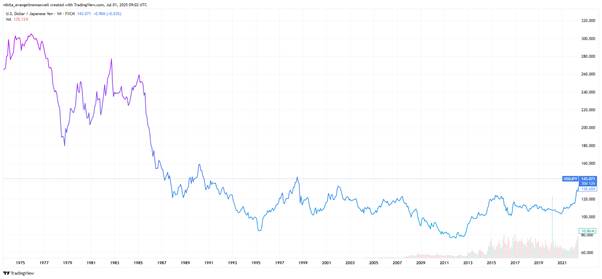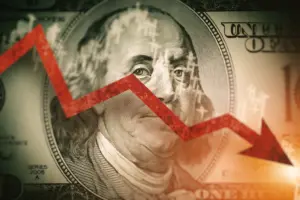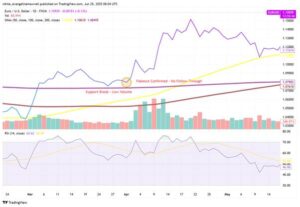Nikkei 225 Chart: 1989 - 2025

Source: TradingView. All indices are total return in US dollars. Past performance is not a reliable indicator of future performance. Data as of 1 July 2025.
You know what’s funny? For most of the last 30 years, nobody really talked about Japanese stocks unless it was to reference that massive bubble in the 1980s. Since then, the Nikkei mostly drifted – some up years, more down years, and a general sense that the whole thing was just... stuck.
But now? Something’s shifted. In early 2025, the Nikkei 225 quietly crossed 40,000. It’s a number, sure, but one that comes with baggage. That was the infamous peak from 1989, a symbol of excess and collapse. So, when the index finally broke through it, people started to pay attention – not just because of the headline, but because this time, the market seems to have real fuel behind it.
The Yen Effect: Tailwind or Mirage?
You don’t have to look too hard to find one of the biggest reasons for Japan’s market rally – it’s the currency. The yen has been in freefall. As of early-2025, the yes was sitting near 160 to the dollar, a level traders had not seen since the 90s. That’s bad news if you’re a Japanese household buying imported groceries or electronics. But for exporters? It’s a windfall.
USD/JPY Exchange Rate (Yen depreciation) 1975 - 2025

Source: TradingView. All indices are total return in US dollars. Past performance is not a reliable indicator of future performance. Data as of 1 July 2025.
Take Toyota, for instance. The company sells cars all over the world, but it books a big chunk of its revenue back in yen. So when the currency weakens, those overseas earnings balloon. Toyota’s latest numbers showed a 78% jump in operating profit – not all of that is currency-driven, but it definitely helped. Its return on equity has climbed to about 12%, up from 9% just a couple years ago. That’s a meaningful shift, especially for a firm that’s usually pretty conservative with capital.
More Than Currency: A Quiet Corporate Revolution
Everyone’s talking about the yen, but honestly, the more interesting story might be what’s going on inside Japanese boardrooms. That’s where the real shift is happening.
The Tokyo Stock Exchange has started putting real pressure on listed companies to do more with their capital – spend it smarter, stop hoarding cash, and actually think about shareholder returns. That kind of push wasn’t taken seriously in the past, but lately? It’s landing.
More companies are buying back shares, raising dividends, and trimming bloated operations that probably should’ve been addressed years ago. It’s not dramatic, but it’s noticeable.
Take Sony. It’s been gradually reshaping itself. The entertainment division has life again, PlayStation is still a beast, and the company has raised its dividend three years in a row. It’s still sitting on over $20 billion in cash, which is no small thing. And even with all the changes, it’s trading at around 22x forward earnings – not outrageous by global standards.
Then there’s Fast Retailing – the group behind Uniqlo. Growth in Japan has slowed a bit, but they’re making real progress overseas, especially in Southeast Asia and India. Margins are improving abroad, and ROE has moved above 14%. They’re not flashy, but shareholder payouts are clearly becoming more of a priority.
Goodbye, Deflation
A less talked-about change is the return of inflation – not too hot, not too cold. For decades, Japan struggled with deflation: falling prices that discouraged both consumers and businesses from spending or investing. But today, core inflation is holding at around 2%, which is healthy by most central bank standards. This allows firms to raise prices without scaring off demand and contributes to more stable earnings growth.
Valuation: A Bargain Compared to the U.S.?
Japanese equities also look appealing from a valuation standpoint. The Nikkei 225 is currently trading at about 15 times forward earnings, that is significantly cheaper than the S&P 500, which sits around 20 times. That gap has caught the attention of global funds. Capital is flowing into Japan-focused ETFs, and major institutions are now overweight the market for the first time in years.
Warren Buffett’s decision to raise his stakes in several of Japan’s major trading houses has only reinforced the narrative: Japan is no longer an afterthought in global portfolios.
Familiar Risks Still Lurk
None of this means the rally is guaranteed to last. BoJ is slowly tightening policy, and if rate hikes come too fast in an effort to stabilize the yen, stocks could wobble. A sharp rebound in the currency could also dampen exporters’ profits.
Japan is closely tied to China’s economy, and any further slowdown there could hit demand for Japanese goods and services. On top of that, geopolitical tensions in Asia – particularly around Taiwan – could weigh on investor sentiment.
Still, these are not new risks. What’s different today is the internal groundwork: leaner balance sheets, better capital discipline, and more willing shareholder engagement.
Final Takeaway
Japan’s stock market has climbed this high before – only to fall back. But this time, the rally appears rooted in deeper change. Companies are stronger, more transparent, and more aligned with shareholder interests. Inflation is no longer a headwind. And global investors are taking notice.
Whether this is the start of a sustained bull market remains to be seen. But if you’ve been ignoring Japan for the past few decades, now might be the time to look at this region again.




